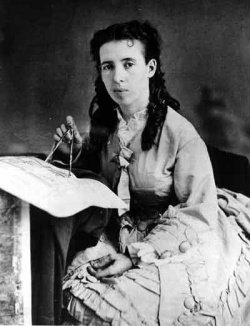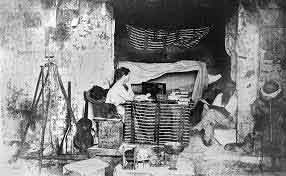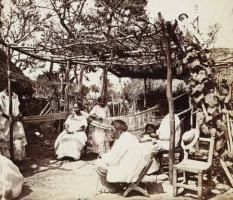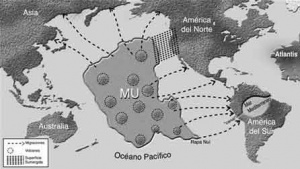Augustus Le Plongeon
Augustus Le Plongeon was a Jersey-born photographer and antiquarian who studied the pre-Columbian ruins of America, particularly those of the Maya civilization on the northern Yucatán Peninsula. While his writings contain many eccentric notions that were discredited by later researchers, Le Plongeon left a lasting legacy in his photographs documenting the ancient ruins. He should also be regarded as one of the earliest proponents of Mayanism.
Le Plongeon wrote a lengthy history of Maya culture, going so far as to propose a theory that Maya had been in touch with the lost continent of Atlantis and were ancestral to Ancient Egypt, a theory which has since been discredited by the scientific community. Le Plongeon, a Freemason, was also convinced that the roots of Freemasonry were to be found in the ancient Maya culture. However, as a pioneer in producing photographic records of Maya sites and inscriptions, Le Plongeon's works retain at least a curio value to later researchers and his photographs preserve the appearance of many sites and objects that have been subsequently damaged or destroyed.
Early life
Le Plongeon was born in Jersey on 4 May 1826. At 19 he sailed to South America and was shipwrecked off the coast of Chile. While there he settled in Valparaiso and taught mathematics, drawing, and languages at a local college. In 1849 he sailed to San Francisco during the California gold rush to work as a surveyor, and also apprenticed to became a doctor of medicine. One of his accomplishments as a surveyor included drawing a plan for the layout of the town of Marysville, California in the Central Valley in 1851.
He moved to England and studied photography with William Fox Talbot in 1851. He returned to San Francisco in 1855 to open a daguerreotype portrait studio on Clay Street. In 1862, he traveled to Lima, Peru and opened another photography studio and an "electro-hydropathic" medical clinic based on an early form of alternative medicine.
Travels in Peru
Le Plongeon pioneered the use of photography as a tool for his studies. He began using the wet collodion glass-plate negative process he used for studio portraits to record his explorations. He traveled extensively all over Peru for eight years visiting and photographing the ancient ruins.
In 1870 he left Peru and traveled back once again to San Francisco where he gave a number of illustrated lectures at the California Academy of Sciences on Peruvian archaeology and the causes of earthquakes. His travels then continued on to New York, and by 1871 he was at the British Museum in London studying Mesoamerican manuscripts. His reading of the works of the French scholar Charles Étienne Brasseur de Bourbourg culminated in a stirring belief that civilization had its origins in the New World.
Alice Dixon Le Plongeon
While in London he met Alice Dixon, the woman with whom he would collaborate for the rest of his life. Alice, born in London in 1851, had been well educated, and also had been taught the art of photography by her father Henry Dixon - a man who was recognized in the late 19th century for his contribution to the development of panchromatic photography.
Alice returned with Augustus to New York, where the couple married.
Travels in Yucatán
In 1873 the Le Plongeons traveled to Yucatán, and remained there almost continuously until 1885 in search of cultural connections between the Maya and Ancient Egypt. They used photography to record the ruins. Their photographic work was methodical and systematic, and they took hundreds of 3D photos. They documented entire Maya buildings such as the "Governor's Palace" at Uxmal in overlapping photos, by placing the camera on a tall tripod or scaffold to correct for perspective, and then processed the plates in the unlit rooms of Maya buildings.
Le Plongeon is also known for his attempted translation of the Troano Codex. The "translation" was viewed with much skepticism at the time, and is considered by all modern authorities to be completely mistaken, based on little more than Le Plongeon's own imagination. He claimed that one section detailed the destruction of the lost continent of Atlantis.
Later career
By the 1880s, while most Mayanists accepted that the Maya civilization postdated Ancient Egypt, Le Plongeon stood by his theories. He cited his years of fieldwork and studies of archival sources, and challenged those he considered "armchair" archaeologists to debate the issues. But as evidence mounted against cultural diffusion, Le Plongeon became marginalized and his theories falling further outside of the growing mainstream of Maya archaeology.
Le Plongeon insisted that the symbols of Freemasonry could be traced to the ancient Maya, and that this ancient knowledge had come to Egypt from the ancient Maya by way of Atlantis.
He was never fully recognized for his work in the Yucatán, but the hundreds of photos he and Alice took still remain an important contribution to American archaeology. Le Plongeon spent the remainder of his life in Brooklyn, New York, writing about the connections between Maya and Egypt and defending himself against detractors. He died in Brooklyn in 1908 at the age of eighty-three; Alice followed in 1910 at the age of fifty-nine.
Published works
A collection of the works of the Le Plongeons currently resides at the Getty Research Institute in Los Angeles. The archive contains original records covering their travels from the 1860s through the early 1900s, including diaries, unpublished scholarly manuscripts and notes, correspondence, and extensive photographic documentation of ancient architecture and sculpture, city views, and ethnographic studies.






